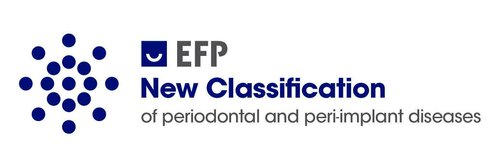![]()
13 December 2018
EFP starts work on toolkit about new classification
Categories:Clinical Practice, Science, New Classification

Work is under way on creating a toolkit for periodontists and other dental professionals to help them implement the new classification of periodontal and peri-implant diseases.
A logo has already been designed and work is now starting on producing a wide range of material that will translate the consensus reports from the 2017 World Workshop into clear written, graphic, and video materials.
All the material will be placed on a dedicated website that will sit within the main EFP website and the toolkit will be presented to the next EFP general assembly, in Bern (Switzerland) on 30 March 2019.
The toolkit will include overview presentations, based on material provided by the four EFP co-chairs of the World Workshop – Mariano Sanz, Iain Chapple, Søren Jepsen, and Tord Berglundh – and Journal of Clinical Periodontology editor Maurizio Tonetti.
These presentations will comprise an introduction to the new classification, plus separate documents covering: periodontal health and gingivitis; periodontitis; periodontal conditions; and peri-implant health, mucositis, and peri-implantitis.
There will also be a series of slide presentations based on lectures by these experts and there will be a series of infographics that will summarise the key information in a visually attractive format. Various videos are also being considered.
The work is being done by the EFP’s professional communications team, under the supervision of Prof Sanz, who is chair of the EFP workshop committee.
The World Workshop on the Classification of Periodontal and Peri-Implant Diseases and Conditions took place in Chicago in November 2017 and the new classification was formally presented for the first time at EuroPerio9 on June 22.
"The success of the new classification system approved by the EFP and the AAP will depend on whether we are able to instruct all general practitioners, specialists, and students on how to implement this classification in the daily care of their patients," said Prof Sanz.
"With this purpose, we are developing a toolkit containing simple documents, slides, videos, and infographics with very clear instructions on how to use the new classification. We shall make this toolkit available globally through the EFP web page and through the EFP national societies, so that this material can be translated and made available to all their members."
Communications progress
Plans for the toolkit and the subsequent training were discussed by the EFP’s communications committee and the federation’s media team at a meeting in Madrid on December 1.
This meeting also reviewed the progress of the EFP’s projects with its partners, noting the successful launch on November 14 of the Perio & Diabetes campaign, which includes a well-received animated video as well as written guidelines and infographics.
Materials for Gum Health Day 2019 were presented by Lior Shapira, the elected member of the EFP executive committee who is co-ordinating next year’s awareness day. These materials, along with advice on topics such as how to organise press conferences, will be sent to the EFP’s 30 national societies of periodontology before the end of the year.
“Like our changeover to a new currency in the past and to new technology every day, the new classification of periodontal diseases is going to seem strange at first, but it will soon become the norm,” said Tiernan O’Brien, chair of the communications committee.
"We will do all we can to provide our national societies and university programmes with the materials they need to facilitate this. Like all new projects, however, we would ask that we all pull together to make this a seamless and positive initiative. There is nothing as constant as change and the EFP is proud to be leading this global transformation.”




